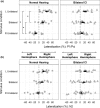Simultaneous bilateral cochlear implants: Developmental advances do not yet achieve normal cortical processing
- PMID: 28413698
- PMCID: PMC5390830
- DOI: 10.1002/brb3.638
Simultaneous bilateral cochlear implants: Developmental advances do not yet achieve normal cortical processing
Abstract
Background: Simultaneous bilateral cochlear implantation promotes symmetric development of bilateral auditory pathways but binaural hearing remains abnormal. To evaluate whether bilateral cortical processing remains impaired in such children, cortical activity to unilateral and bilateral stimuli was assessed in a unique cohort of 16 children who received bilateral cochlear implants (CIs) simultaneously at 1.97 ± 0.86 years of age and had ~4 years of CI experience, providing the first opportunity to assess electrically driven cortical development in the absence of reorganized asymmetries from sequential implantation.
Methods: Cortical activity to unilateral and bilateral stimuli was measured using multichannel electro-encephalography. Cortical processing in children with bilateral CIs was compared with click-elicited activity in 13 normal hearing children matched for time-in-sound. Source activity was localized using the Time Restricted, Artefact and Coherence source Suppression (TRACS) beamformer method.
Results: Consistent with dominant crossed auditory pathways, normal P1 activity (~100 ms) was weaker to ipsilateral stimuli relative to contralateral and bilateral stimuli and both auditory cortices preferentially responded to the contralateral ear. Right hemisphere dominance was evident overall. Children with bilateral CIs maintained the expected right dominance but differences from normal included: (i) minimal changes between ipsilateral, contralateral and bilateral stimuli, (ii) weaker than normal contralateral stimulus preference, (iii) symmetric activity to bilateral stimuli, and (iv) increased occipital lobe recruitment during bilateral relative to unilateral stimulation. Between-group contrasts demonstrated lower than normal activity in the inferior parieto-occipital lobe (suggesting deficits in sensory integration) and greater than normal left frontal lobe activity (suggesting increased attention), even during passive listening.
Conclusions: Together, findings suggest that early simultaneous bilateral cochlear implantation promotes normal-like auditory symmetry but that abnormalities in cortical processing consequent to deafness and/or electrical stimulation through two independent speech processors persist.
Keywords: auditory brain; beamformer; bilateral cochlear implant; children; cortical aural preference; cortical lateralization; development; electro‐encephalogram; hearing loss; speech perception.
Figures







References
-
- Alain, C. , He, Y. , & Grady, C. (2008). The contribution of the inferior parietal lobe to auditory spatial working memory. Journal of Cognitive Neuroscience, 20, 285–295. - PubMed
-
- Benjamini, Y. , & Hochberg, Y. (1995). Controlling the false discovery rate: A practical and powerful approach to multiple testing. Journal of the Royal Statistical Society Series B (Methodological), 57, 289–300.
-
- Blair, R. C. , & Karniski, W. (1993). An alternative method for significance testing of waveform difference potentials. Psychophysiology, 30, 518–524. - PubMed
-
- Cavanna, A. E. , & Trimble, M. (2006). The precuneus: A review of its functional anatomy and behavioural correlates. Brain, 129, 564–583. - PubMed
-
- Ceponiené, R. , Alku, P. , Westerfield, M. , Torki, M. , & Townsend, J. (2005). ERPs differentiate syllable and nonphonetic sound processing in children and adults. Psychophysiology, 42, 391–406. - PubMed
Publication types
MeSH terms
Grants and funding
LinkOut - more resources
Full Text Sources
Other Literature Sources
Medical

